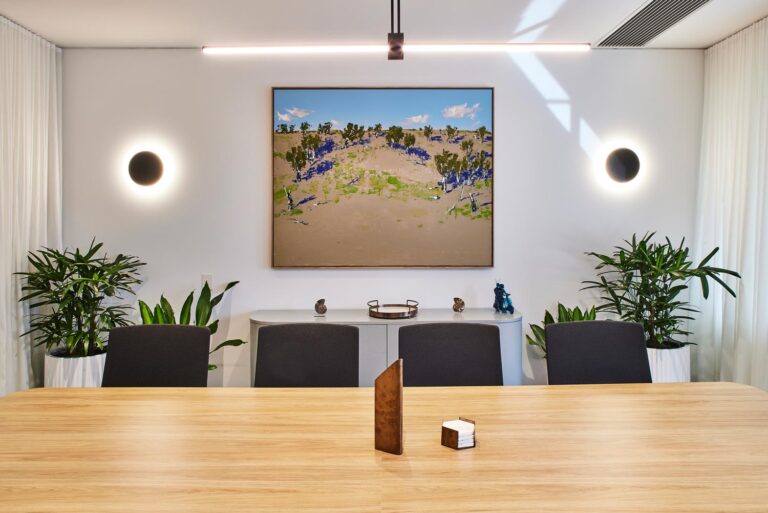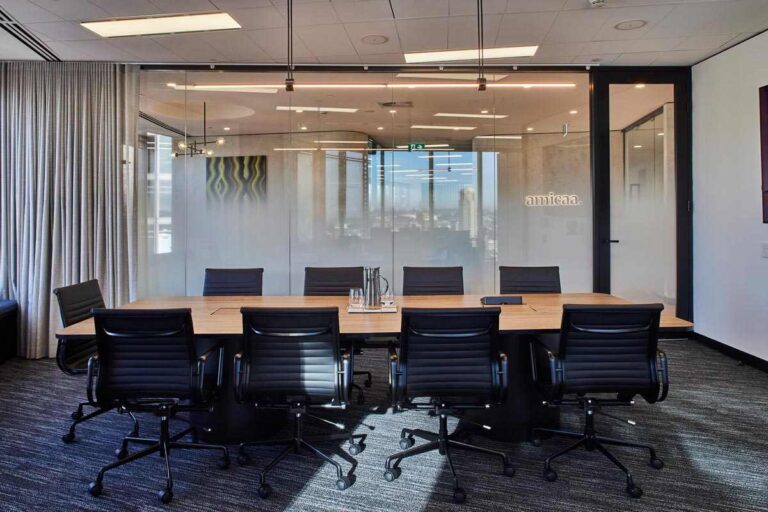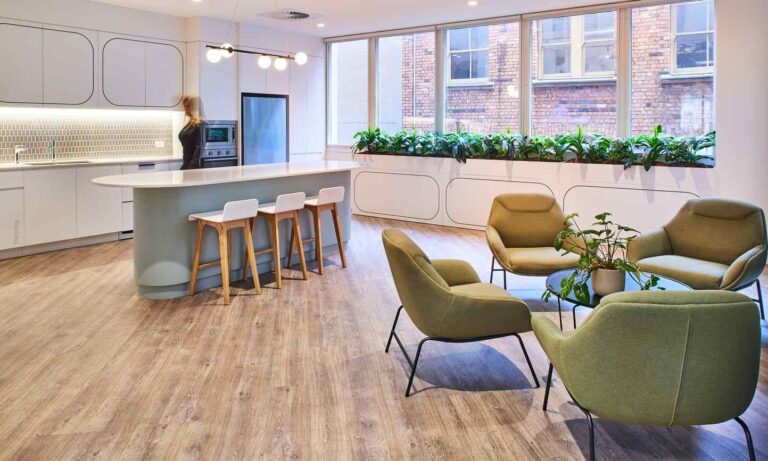Coping with a lot of traffic, mess and heavy wear, floor coverings are an area where it is important to prioritise function over form – of course, it’s possible to achieve both beautiful and practical.
To start, we recommend working with your design and fitout partner to cater for your functional requirements for your business, before working on the look and feel.
Factors to consider when choosing the best office floor coverings:
Your budget
It’s important not to cut corners on quality flooring, or you’ll quickly find yourself replacing worn areas. On top of the square metre raw material cost, be sure to factor in costs of installation, maintenance costs and lifetime durability. Flooring is an area where practical choices make sense for most areas, with touches of designer style in lower traffic areas.
Size of your space
For large fitouts, changing up your choices of flooring throughout your office can distinguish between different work areas and break up the space visually. For smaller areas like kitchens, bathrooms or meeting rooms, lighter colours and larger tiles or wider floorboards can add to the sense of space.
Purpose of the area
Different spaces require dramatically different flooring choices. Warehouse areas, open plan offices, retail or reception areas, private meeting rooms or kitchens lend themselves to specialised flooring. Consider foot traffic, mess, cleaning requirements. For example wall to wall tiles are perfect eating areas, but can be unwelcoming and noisy in interview areas.
Your brand and image
As the foundation of your office look and feel, floor coverings are a critical decision. While you want all the spaces to work together aesthetically and functionality, it’s certainly not one size fits all. All the design elements need to complement each other to reflect how you want your business to be perceived. Make flooring decisions as part of your overall design concept.
Acoustics
If you’ve been to a noisy restaurant where you can’t hear yourself think, you’ll understand how floor choices can change the dynamic of a space. Ceramic tiles can create the wow factor in your foyer, but more noise absorbing textures like carpet, stone or timber can be practical for conference rooms. Furniture, ceiling fittings, rugs and plants are also important for good acoustics.
Safety and comfort
When choosing flooring it is important to balance functionality with aesthetics, creating a positive environment for staff, clients and visitors. If your employees are in an office space that they enjoy being in, it can boost morale as well as productivity. For example tiles that become slippery during rain or after cleaning are a dangerous and surprisingly common mistake.
Pros and cons of popular office floor coverings
Carpet
Pros: Available in endless patterns, designs, colours and styles, carpet lets you create the exact look you want to reflect your brand – you can even include your logo or custom designs. Different colours or patterns can easily be used to differentiate work zones. Carpet absorbs sound so it is ideal for open plan offices or meeting rooms. As well as having a warm and welcoming feel and being cost-effective, carpet provides cushioning under foot and is non-slip. Carpet tiles are outstanding these days and are the preferred choice in the majority of office fitouts.
Cons: Most carpets are not water resistant so they don’t work well in or near eating areas, kitchens or bathrooms – other spills such as coffee, wine or chemicals can also be hard to remove. As it collects dust, carpet will need to be vacuumed and cleaned frequently. While dark-coloured commercial carpets can be very durable and stain resistant, many of the more stylish or light-coloured carpets can stain or wear out in high traffic areas. Carpet tiles can also be useful as they allow you to replace specific areas without recarpeting.
Polished concrete
Pros: Polished concrete gives a modern urban feel and offers rock-solid durability for high traffic areas or spaces dealing with trolleys, vehicles, hard wear or use of water. Its reflective surface can brighten up a space that doesn’t get much natural light, and it can be colour-treated for a unique look. As concrete can absorb and release heat, it can make heating or cooling the space more energy efficient and can save you money in the long term. Concrete is easy to clean with regular sweeping or mopping.
Cons: Concrete can stain if it’s not sealed properly and can be echoey for large areas. While there are limited design options with standard concrete, it is possible to customise your concrete floor with colour tinting and even stencilling in company logos or wording.
Tiles and pavers
Pros: From ceramic or porcelain tiles to natural stone pavers, floor tiles are available in a range of styles, colours and materials. Tiles not only look impressive, but like polished concrete they are durable, hard wearing and easy to clean. They make a great first impression in a foyer or lobby area, and are ideal for high traffic areas. Water-resistant tiles work well in wet areas like bathrooms, kitchens and workshops.
Cons: While they are always a top performer, many tiles and pavers can be cold underfoot, expensive to replace if cracked and noisy in large open areas. Glossy tiles can also get very slippery when wet.
Vinyl
Pros: While in the past vinyl has had a reputation for not looking premium quality, it has come a long way in the last few decades and is worth a second look. With many designs to choose from, including plenty of beautiful premium options like realistic wood and stone imitations you can achieve a premium look without the hefty price tag. Vinyl is now also available in attractive planks that look and feel like timber flooring – even a trained eye would have trouble picking it from real timber. A vinyl floor is easy to clean and maintain by standard cleaning processes to remove dust and grit. It is cost-effective, simple to install, durable and resistant to water damage.
Cons: Vinyl floors may become dented by sharp or heavy objects so you’ll need to consider what you’ll be using the space for. Vinyl can also emit volatile organic compounds (VOCs), so be sure to check with your supplier. Vinyl floors can be difficult to remove and/or replace if they are damaged.
Timber
Pros: A timber floor not only looks stylish, but it is also durable, easy to clean and with proper maintenance it can last a lifetime. Coming in a variety of grains, colours and widths no two wooden floors will be exactly the same. you can create just the look you are after. If used in the lobby, foyer or reception area, it can set a professional tone for your whole office space. Long-term it can be sanded back and repolished to make it look like new. Many sustainable and renewable options are also available.
Cons: In terms of raw material and installation timber floors can be more expensive than other options, although they are made to last and relatively simple to maintain. Softer timbers can be prone to scratch or denting in high impact areas, for example pointed stilettos can sometimes cause dents. Be careful not to over-polish, otherwise the floor can become very slippery.
What to know more?
If your business is based in the Sydney CBD or North Sydney, Vestra can help you with all your office fitout requirements including choosing the best office floor coverings.
With proven experience designing commercial interiors, our fully integrated team offers a complete design and construct service with end-to-end project management and competitive pricing. Our team takes a collaborative approach and can work with you to create an individualised workplace.
From your floor plan and floor coverings to electrical and lighting solutions, our expert planners and designers will take the time to understand your unique business requirements and help you bring your vision to life.
Contact us today to arrange a no-obligation consultation.


